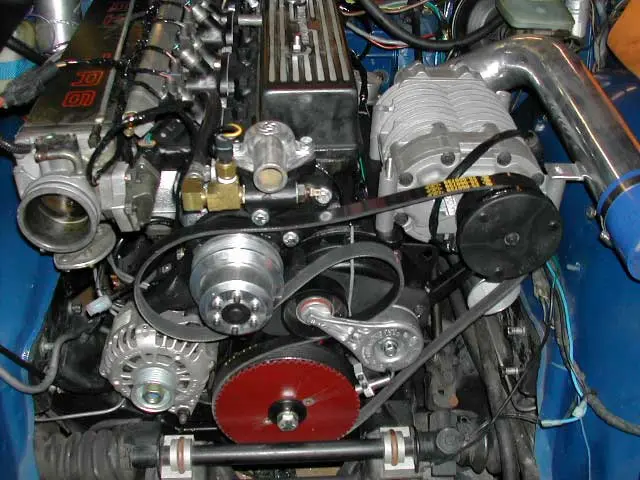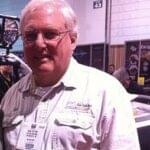Supercharged Engine Build

Summer 2005
Here we are in 2005 and it’s finally engine rebuild time. The original 1975 straight six now shows over 80K on the speedo and makes that tell tale puff of blue smoke when shifted hard. In fact the odometer didn’t work for several years so the mileage is probably closer to 100K.
Still going strong and for some unknown reason smoking less these days (could it be out of oil?), no, I don’t think so. Just so happens that I have a spare engine that came out of a car with about 40K miles so it will be a great candidate for the rebuild. This engine rebuild is all part of a major upgrade and will be combined with adding a supercharger and overdrive all at the same time.
A condition necessary to supercharging is a low compression engine. My rebuild candidate is an early engine with an 8.5:1 head and narrow intake port spacing so a late model head was needed. A plea on the Triumph 6-Pack discussion group yielded several candidates with the closest in Boston from BobLang, a top notch SCCA competitor. The new head is a late model 7.5:1 that needed rebuilding but was a solid circle “B” head.
The head was cooked to remove all grease and rust and the valves ground. Then I decided that it should be ported , something that I’d never done before. Too late now but the porting should have been done before the valve job. Next time. Anyway I started porting with guidance from the Competition Preparation Manual, an air die grinder, and various stones and carbide burrs. The die grinder is only hand size but consumes so much air that my compressor is running a marathon trying to catch up. Tired of listening to the compressor and in an effort to save electricity I purchased an electric die grinder by Milwaukee and a carbide burr with a six inch long shank. What a difference! The new grinder instantly more than doubled my productivity.
August 11, 2005: All six intake runners have been ported and two intake valve bowls have been shaped. It will take another eight hours or so to finish porting and clean up the combustion chambers. Although I’ve rebuilt a number of engines I’ve never cc’d a head so this will be the first.
Tomorrow August 12th the block and the crank will be ready at the machine shop. The block has been bored .020″ and the crank turned 10/10. The crank will be balanced with the Cadillac Northstar harmonic balancer (for use with a serpentine belt compatible with the supercharger clutch) and lightened flywheel.
A new camshaft from Integral Cams designed for a supercharged TR6 will be fitted along with reground lifters. The cam is used with stock rockers and is classified as a Stage 1 in that it makes power at lower rpms and will idle smoothly. Integral agreed that between fuel injection, a supercharger, and this cam we should be able to approach two hundred flywheel horses.
Part of this same effort is the addition of overdrive to the stock four speed transmission. A friend kindly donated an overdrive from a turbo Volvo. A spare transmission was rebuilt and the mainshaft replaced with a new shorter OD shaft from Quantum Mechanics. Quantum also supplied the adapter that couples transmission to the overdrive and some great advice. The transmission needed new bearings and a second gear bushing. The overdrive needed new operating pistons, clutch, relief spring, gaskets and seals. A Volvo drive flange that mates to the TR6 driveshaft was donated by the late Don Malling.
Saturday August 12th. The head porting is finally done and if I may say so myself, came out quite nicely. More smoothing and polishing could be done but according to the experts there is little to be gained. Another first for me was CC’ing the combustion chambers. Actually it also went quite well and all chambers came within a tenth of a cc of each other! The average chamber measured 59.3 CC’s. Doing the math or actually using an online compression ratio calculator compression ratio came out to 7.63:1. The figures for the calculation are: Combustion chamber size 59.3 CC, bore 2.9605, stroke 3.74″, deck height is 0.010″, gasket thickness is .040. I’m going to have another 0.015″ taken off the head to get the compression ratio closer to 7.75:1. Looking forward to checking “Cylinder Head” off my list of things to do.
Tonight Aaron Cropley stopped by and we installed the cam bearings using a home made slide hammer and aluminum bushings that just fit the cam bearings. They are in and the new cam installed. The cam can be spun by hand but is a little tighter than I’d like. Bob Bailey, the engine builder, has offered to polish the cam for a little extra clearance so I will probably take him up on it. Pretty sure things would be fine the way they are but I don’t want to take any chances.
The stock connecting rods in this engine weighed 684.4 grams on average. After cleaning off flash etc and polishing they weighed 660.6g within a couple tenths of a gram. I asked the engine builder about using ARP bolts and he said stock bolts were more than sufficient for my use. The engine should turn 6K and be somewhere around 200HP.
Balancing of the rotating parts went exceptionally well. The reground TR6 crank by itself measured well within spec with no changes and adding the flywheel to it made the balance even better! Bob said it was the best balanced crank/flywheel he had seen and that is something coming from a top race engine builder. When I asked him if I was cleared for a 6,000 redline he just smiled and said sure. By the way, after he bored the engine to a rough measure, he then honed it the final few thousandths. The hone used is a very high end machine that makes the bores absolutely round, top to bottom. I know that all machine shops claim they bore accurately but most are not as accurate as you might think as few machines have the capability. The true round bores will ensure that the rings seat perfectly. The engine was bored over 0.0205 with that extra half a thousandth clearance in case there is excessive heat generated by the supercharger.
All that’s left to do is finish assembling the engine and mate it to the overdrive transmission.

